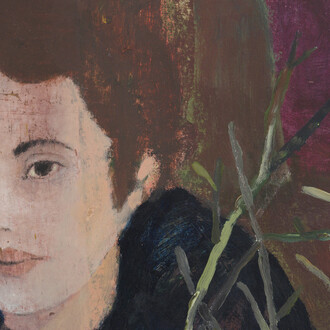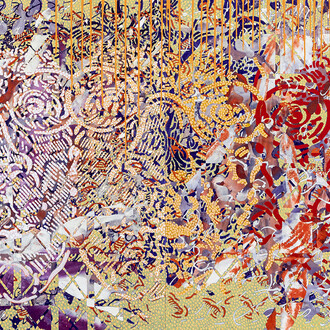As demonstrated by the retrospective exhibition in the Musée d’Art Moderne et Contemporain in Saint-Etienne entitled "Bas Voltage / 1960-2019", which runs until 22 September 2019, Pierre Buraglio, a painter and draughtsman, has also regularly practised the printed arts and applied arts.
This exhibition explores these practices via a new editorial project of printed works and a selection of applied art objects.
Following on from his previous exhibition in the gallery, for which he had produced an unprecedented number of monumental prints, the artist has repeated the experience with a 769 cm-long frieze named after Jean-Jacques Rousseau’s work Les rêveries d’un promeneur solitaire (The Reveries of a Solitary Walker). On a blue ground, in a facsimile of "Gauloises" paper—a reference to his emblematic works from the beginning of the ‘80s—Pierre Buraglio created a promenade that begins where he lives at 20 Avenue Gambetta. He borrows images from street art, quotes verses by Baudelaire, uses his own drawings or extracts of anonymous paintings, and creates his work, leaving traces of torn areas visible here and there, which attest to the different stages of the project.
Pierre Buraglio has harnessed all the potential of digital technology, in collaboration with the Studio Franck Bordas, a longstanding partner, to create this urban fresco. He has conducted similar experiments in two commissions for museums: "46", for the Musée des Beaux Arts in Caen, a pigmentary digital print in two parts which is more than four metres high, which can be seen in the exhibition "XXL estampes monumentales contemporaines" (XXL contemporary modern prints’) until 15 September, and he created "68-2019"(with the same dimensions) for the Musée de Saint Etienne as part of his retrospective.
The composite work, "Les rêveries d’un promeneur solitaire", in the gallery may be presented in different sections, via a novel creative approach that involves variable dimensions, in which each visitor can select an extract of the work. An ensemble of drawing and prints based on the same theme complements and extends this walk in the Val-de-Marne.
As a pendant to this printed mural work, the gallery has decided to present a range of objects related to the decorative arts.
Just as he reworked the components of the picture, to incorporate art into daily life, Pierre Buraglio has experimented with utilitarian objects using waste materials: a window mirror, a brick base, firebrick bookends, a clipboard made from a window post, and enamelled metal sheet. Certain objects are related to commissioned works such as the fruit dish produced by the Réunion des Musées Nationaux (surmounted with papier mâché by Claude Buraglio), the scarf for the Brochier silk works in Lyon, a screen commissioned by Elizabeth de Portzamparc for her Galerie Mostra, and the Diane dinnerware for the Manufacture de Sévres. And, for this exhibition, Pierre Buraglio has created three examples of a rear-view mirror. At the boundary between the object and printed art, several series of the artist’s postcards are also displayed, in particular those produced by Michel Lunardelli, in original lithographs.








![Bernard Moninot, Le vent cesse [The wind drops], exhibition view. Courtesy of Galerie Catherine Putman](http://media.meer.com/attachments/017a65c2956c13287081f216dd53c889ef4b5746/store/fill/330/330/418cdf2c327dafedc4a27c78aeb72852dd2543011d1cba893e2308969dfe/Bernard-Moninot-Le-vent-cesse-The-wind-drops-exhibition-view-Courtesy-of-Galerie-Catherine.jpg)







